NPS Website; Local Website
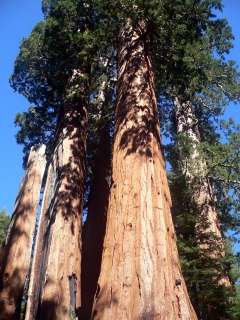 WHAT IS IT?
WHAT IS IT?Two large (736,000 acres), diverse (14,000 feet in elevation difference) and jointly run National Parks nestled in the Sierra Nevada wilderness of east central California. The Parks include most of the world’s giant sequoia trees, including the largest three trees on the planet. Other highlights include a canyon deeper than the Grand Canyon and Mount Whitney, the tallest mountain in the continental United States. Superlatives aplenty in this mountain wonderland.
BEAUTY (10/10)
At Sequoia NP, immerse yourself in the shadow of these giant trees. Look at them, stare at them and listen to them. They have been living here for over 2,000 years. Climb atop Moro Rock and look down into the deep canyon valley. If you are as lucky as we are, all you will see is a soft blanket of puffy clouds. We were on top of the world.
At Kings Canyon NP, be awed by the canyon’s ethereal beauty. Stand next to the raging violence of the Kings River, too dangerous for even the most experienced kayakers and rafters after the snow melt. Hike amid the granite walls and peaceful forest past the aptly named Road’s End. Snow prevented us from going backcountry at Kings Canyon, but we would love to go back. Kings Canyon was our favorite part of the Parks and one of the most beautiful places we have ever been.
HISTORICAL INTEREST (4/10)
Sequoia NP became our nation’s second National Park in 1890. (Third if you count Hot Springs NP in Arkansas, which the NPS oddly does not). It was made a park, with the help of famed naturalist John Muir, in order to hold off the insatiable appetite of loggers. The Museum showcases still photos of proud loggers standing astride downed 2,000-year old trees.
These pictures are profoundly sad and a sobering reminder of our lust to utilize the earth’s unique treasures for our short term personal gains. The sick irony is that the nearly immortal giants’ wood, impenetrable to fire, insects, fungi and birds, is too soft to be used for building purposes. The majority of the downed giant sequoia wood was used to make pencils. Thank you John Muir for being a strong loud voice in an insane age.
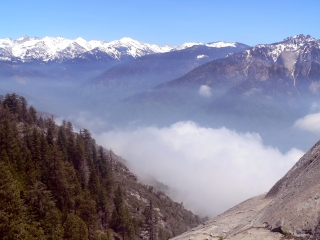 CROWDS (4/10)
CROWDS (4/10)If crowds mean only people, then this rating is high. There were enough campsites for everybody and enough space to roam. The crowds were full of friendly, courteous and experienced hikers.
Our crowd rating reflects our experience with problem black bears. One, maybe two, camp invaders, made our first night a stressful affair. As of mid-May, the Potwisha campground had already seen 16 bear car break-ins. A bear victimized a car next to our campsite the night prior to our visit. Under strict instruction, we took everything out of our car and trunk, even scentless cardboard boxes, and stuffed it into a bear box. Just to be safe.
We think we heard bears near our tent during our sleepless night, but luckily, the Altima emerged unharmed and unexpectedly much cleaner. We just wish we had had a vacuum, then the job would have been perfect. Mental note, no more eating bagels in the car just before going into bear country. The three nights we spent at the Park were tense, restless affairs.
EASE OF USE/ACCESS (1/5)
Sequoia NP has only two entrances. There is only one route into Kings Canyon NP; you must enter via Sequoia NP and Calif. Route 180.
Calif. Route 180 enters the Sequoia NP in its northwestern corner, the Big Stump entrance, near the General Grant Grove of giant sequoia trees. Fresno, Calif. is about 50 miles west of Grant Grove. The Kings Canyon NP entrance is 30 miles east of Grant Grove on Route 180. This stretch of 180 is open only during summer. The road is very steep and will take at least an hour to traverse.
Sequoia NP’s other entrance, the Ash Mountain entrance, is at its southwestern corner on Calif. Route 198. Visalia, Calif. is about 30 miles west of the Ash Mountain entrance along 198.
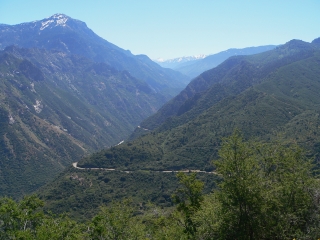 The Generals Highway connects the two entrances of Sequoia NP. The General’s Highway is narrow and takes innumerable twists and turns. Downshift often, check your breaks and don’t come here unless you have power steering. RV’s are not recommended. The General’s Highway is about 60 miles long but conditions make it at least a three-hour drive.
The Generals Highway connects the two entrances of Sequoia NP. The General’s Highway is narrow and takes innumerable twists and turns. Downshift often, check your breaks and don’t come here unless you have power steering. RV’s are not recommended. The General’s Highway is about 60 miles long but conditions make it at least a three-hour drive.Roads cover only a small portion of the two Parks and nothing but the heartiest of travelers crosses the High Sierras. If you want to backcountry hike and camp, you are going to have to wait until late June, early July for all the snow to melt. Even though Mount Whitney lies within Sequoia NP’s boundaries, most climbers begin their ascents from the Sierra’s eastern face, the Mount Whitney Portal at Inyo National Forest.
CONCESSIONS/BOOKSTORE (3/5)
Nothing to knock your socks off at any of the bookstores. The obligatory nature guides and usual NPS fare are for sale here.
There are no free trail maps at Sequoia and Kings Canyon NP. Any hiking beyond the well-marked, but still snow covered trails around the Giant Forest Museum or away from the very warm foothills requires the purchase of a more detailed map. The $3 price tag won’t break the bank, but it was enough to discourage us from buying one.
COSTS (2/5)
Entry is $10 per vehicle, free with the National Parks Pass. Campsites are a pricey $18 per site. New window and new door post-bear break-in should be covered by your insurance. We were lucky enough to enjoy the last free camping night at the Lodgepole campground. Located at 6,720 feet, winter nights get prohibitively cold. If you are willing to bundle up, winter camping is free. The $18 fee only applies to summer.
Tours of Crystal Cave are expensive at $10.95 per person, a higher sum than the basic tours at the World Heritage Sites of Mammoth Cave NP and Carlsbad Caverns NP.
Be forewarned, there is no gasoline sold in the Park. Fill up before you get here.
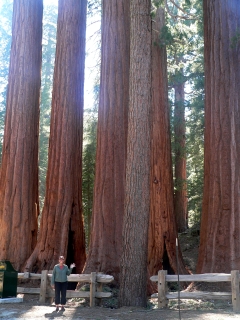 RANGER/GUIDE TO TOURIST RATIO (3/5)
RANGER/GUIDE TO TOURIST RATIO (3/5)There are plenty of Rangers and plenty of Ranger Stations but few helpful Rangers. We asked five different Rangers what to do at their Park. All castigated us for not reading the Park newspaper (we had!) and treated us disdainfully. We just want to hike and have a good time, really we do. Eventually we shrugged their dismissals off and notched them to the “its about to be the busy season and the winter snow stayed late and there is too much still to do so go away” blues.
TOURS/CLASSES (4/10)
Read the Park newspaper for a summary of hikes and highlights of each section of the Parks. Sequoia Park is divided into Giant Forest, the Foothills and Mineral King; Kings Canyon is separated into Grant Grove and Kings Canyon and Cedar Grove.
Regularly scheduled Ranger programs begin late in June at Cedar Grove and Grant Grove. You might catch a Ranger-guided walk around Grant Grove on Saturday and Sunday afternoons before then. For some reason, there are no programs at all between May 31st and June 16th.
The Giant Forest Museum is a nice stop on a driving tour through the Parks. Interactive displays let you pretend to scale the mighty Sentinel Tree as you walk along its measured shadow on the footpath. Inside, step into a room as large as a sequoia stump and spin the big wheel to see what chances a sequoia seedling has to survive in the big bad forest. Even these regal giants start out small and vulnerable.
The Big Trees Trail begins just outside the Museum. Unlike other trails in the Parks, this one is paved, accessible and does not require a map. Trailside panels give an overview of the Parks’ ecology as you stroll alongside a meadow lined with towering redwoods and sequoias. The open meadow allows sun to shine in and ensures good photos on at least one side of the walk any time of day.
FUN (9/10)
Only the thought of rogue bears destroying our car dampened our fun. OK, that is a pretty big damper, but heck, we had a lot of fun. Every hike we took we loved.
Sequoia and Kings Canyon NP is similar to its High Sierra neighbor, Yosemite NP, only more remote, without the hype and without the overwhelming crowds. Even on the weekend, Sequoia and Kings Canyon NP’s campsites were not full. We did not have to stress about rushing through the Park. We could take our time and could stay overnight. We had a great time.
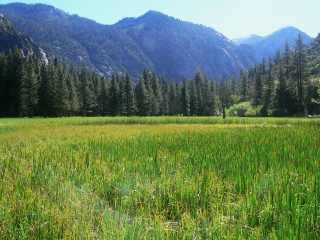 WOULD WE RECOMMEND? (10/10)
WOULD WE RECOMMEND? (10/10)We spent several days in Sequoia and Kings Canyon NP. Each day got better and better. We began our visit in the Foothills and worked our way up and into Kings Canyon and Cedar Grove. The drive east on 180 through the Sequoia National Forest follows the aptly named Kings River. This majestic force of water escorted us into the Canyon and all the way to Road’s End, where we have a feeling the real and rugged beauty of the Park just begins.
TOTAL 50/80
www.usa-c2c.com
© 2005